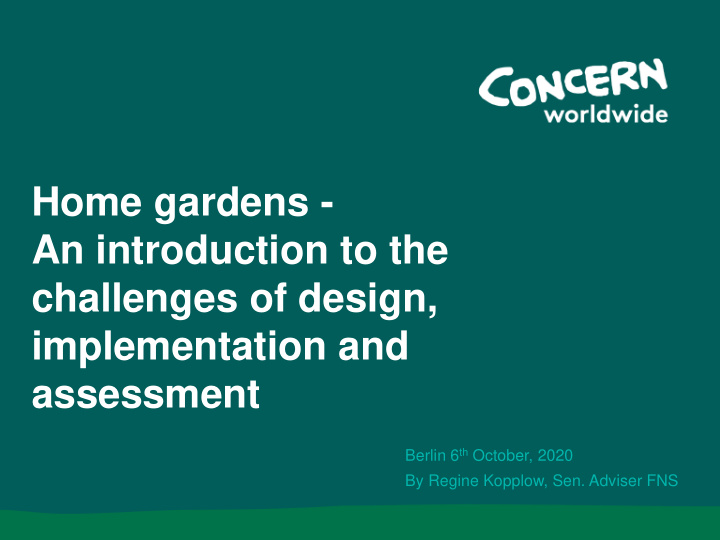



Home gardens - An introduction to the challenges of design, implementation and assessment Berlin 6 th October, 2020 By Regine Kopplow, Sen. Adviser FNS
Background – Home Gardening in Concern ■ Home gardens are very common ■ Concern Worldwide supports them in various forms across many countries Households supported Resilience programming Humanitarian response in with home gardening * refugee/ IDP camps 2018 2019 42,747 103,852 Afghanistan, Burundi, CAR, Bangladesh (Cox’s Bazar) Chad, DPRK, DRC, Liberia, Ethiopia (Gambella), Malawi, Niger, Pakistan, Lebanon, Syria, South Rwanda, Sierra Leone, Sudan (Bentiu, Juba) Somalia, Sudan ■ Not one size fits all ■ Require careful planning, implementation, monitoring *) taken from Concern’s Country Annual Programme Progress Reports 2018 and 2019
10 key aspects to consider Definition - What is a home garden? 1. Objective - What to achieve? 2. Sector - Where does it sit? 3. Beneficiaries – Whom to target? 4. Design – Which is best? 5. Crops – What to grow? 6. Inputs – How to ensure sustainable access? 7. Skills – What is essential to know? 8. Produce - What to do with it? 9. 10. Results - How do we know?
1. Definition - What is a home garden? Concern’s definition: a small plot beside the house used for growing vegetables and fruits mainly for home consumption. Home gardens are: Near to the home, small, extremely high yielding • • Often managed by women but not necessarily • Vegetables, fruits, herbs, sometimes small livestock/ poultry Mainly for home consumption but surplus is sold • • Produces all-year-round, factors in seasonality of crops • Labour intense, requires sustainable access to quality inputs Many designs exist (keyhole, sack, raised beds etc.) • • They can significantly contribute to the food security of households! Recommendation 1: Have an agreed definition across the organisation.
2. Objective - What to achieve? Home gardens contribute to higher level outcomes as • part of a larger programme • Gardens are associated with (for example): • Improved access to food (or specific crops) • Improved dietary diversity; • Diversified/ increased income; • Improved access to resources by women; • Changes in decision making by women; • Objective determines how to implement gardens Recommendation 2: Develop a theory of change to be clear how home gardens will contribute to the programme’s overall objective.
3. Sector - Where does it sit? • home gardens are multi-sectoral linking agriculture, nutrition and gender equality YYYYYYYYYYYYY XXXXXXXXXXX YYYYYYYYYYYYY XXXXXXXXXXX YYYYYYYYYYYYY XXXXXXXXXXX YYYYYYYYYYYY… XXXXXXXXXXX ZZZZZZZZZZZZZ . XXXXX…. ZZZZZZZZZZZZZ ZZZZZZZZZZZZZ Z…. Nutritionist Agriculturalist Gender Specialist Recommendation 3: make sure you work closely with the other sectors
4. Beneficiaries – Whom to target? ■ Concern targets extreme poor households ■ Little to no land ■ Labor constraint ■ Lack of agriculture tools, seeds, knowledge, etc. ■ Depend on rainfall ■ Poor soils ■ Often displaced, living in camps or host communities ■ Consider women’s workload! Recommendation 4: Know existing capacities and barriers to gardening your beneficiaries might have and tailor your intervention towards addressing those.
5. Design – which is best? Keyhole garden in Kirundo/Burundi, Concern Sack garden in Tahoua/ Niger, Concern Sack Garden Camp 18 , Demo plot communal in Pugnido kitchen, camp/ Cox’s Bazar/ Gambella/ Bangladesh, Ethiopia, Concern Concern Recommendation 5: Give people choices
6. Crops – What to grow? Prioritise vegetables/ fruits that are • Highly nutritious • Tolerant to poor soils, drought, pests • Fast and easy to grow • Easy to save seeds from • Allowing daily harvest • Providing leaves, seeds and the vegetable itself • Stored or transported with little loss • Easy/ fast to cook • Liked by children Recommendation 6: Promote vegetables/ fruits that meet the above criteria.
7. Inputs – How to ensure sustainable access? ■ Conduct a market assessment ■ Provide cash or vouchers ■ Only consider in-kind support if cash or vouchers are not feasible Bulking of produce; RAIN Programme, Western Province/ Zambia, Concern Recommendation 7: Use a market-based approach for garden inputs
8. Skills – What is essential to know? ■ Provide what is essential, not what is ideal ■ Focus on what is relevant ■ Hands-on, practical ■ Align training content to growing stage ■ Strengthen already existing cadres of trainers Recommendation 8: Provide a mixture of agriculture, nutrition and equality skills essential to home gardening
9. Produce - What to do with it? Participatory cooking session, Pugnido 1, Gambella/ Bilkis and Sultan selling vegetables in Karwan Bazar, Dhaka, Ethiopia, Concern Bangladesh, Concern • Home consumption is prioritised • Women decide what is sold • Women control the income • Money is used to satisfy other basic needs Recommendation 9: Prioritise home consumption but accept that surplus is sold.
10. Results - How do we know? Pugnido 1, Gambella, Ethiopia (targeting 5,250 female headed households) • 94% of gardens functional • 82% consumed vegetables from their garden every day • Use of produce: 74% consumed only; 25% consumed & sold 87% use the income for health, education, household • utensils, repair • They felt healthier as a result of eating diversified food; • Owning a garden gave them a sense of independence; Recommendation 10: Carefully assess outputs and outcomes of home garden intervention
Recommend
More recommend